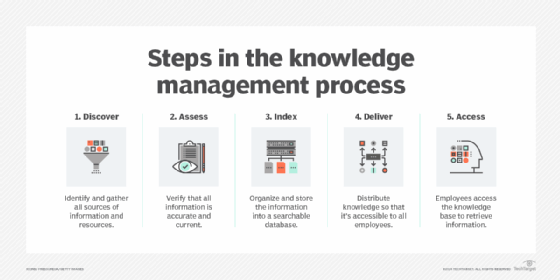How knowledge management benefits customer service (original) (raw)
As knowledge management helps employees and customers find answers, it can improve customer service. Benefits include effective self-service and increased customer satisfaction.
An effective knowledge management strategy can improve many business functions, especially customer service.
In an age where organizations have access to massive amounts of customer data and sophisticated AI technologies, consumers expect excellent service. They expect organizations to anticipate their needs and provide immediate answers to their questions. A knowledge management (KM) strategy can improve customer service by making information easily accessible to employees and customers.
The benefits of KM in customer service include the following:
- Effective self-service.
- Enhanced remote work.
- Improved first call resolution (FCR) and average handle time (AHT).
- Increased customer satisfaction (CSAT).
- Streamlined agent onboarding and training.
"Knowledge management is absolutely foundational to everything you do in customer service," said Kate Leggett, an analyst at Forrester Research. But until the proliferation of remote work and generative AI (GenAI) in the early 2020s, organizations often overlooked KM.
To keep up with consumer expectations, customer service managers should know what KM is, how it can improve contact center operations and how GenAI can help.
What is KM in customer service?
KM is a process that organizations use to identify, capture and disseminate knowledge to employees and customers. The process involves codifying explicit knowledge -- objective knowledge organizations can easily articulate -- and tacit knowledge -- experiential know-how -- into accessible and searchable formats like FAQ pages, training videos and product guides.
Explicit knowledge can include product specifications and company policies. Tacit knowledge might include a customer service agent's tips on how to empathize with irate customers.
In a customer service context, a key KM goal is to create the following:
- Internal knowledge base. This type of knowledge base is a central knowledge repository accessible to employees only. Customer service agents can search through it to find internal protocols and up-to-date training materials.
- External knowledge base. Employees and the public can access this type of knowledge base, typically on the web. These systems often contain FAQs, user manuals and information about product returns and warranties.
5 benefits of KM in customer service
A KM strategy breaks down data siloes and stores knowledge in centralized and easily accessible repositories. Benefits include effective self-service, enhanced remote work and improved contact center metrics.
1. Effective self-service
As customers increasingly prefer to interact with organizations through self-service channels, external knowledge bases can meet their expectations. Customers can search these repositories to quickly find answers to their questions at all hours of the day, reducing contact center volume and giving agents more time to handle complex inquiries.
 Kate Leggett
Kate Leggett
However, organizations must ensure customers can escalate to live agents if necessary. Some interactions require a human element.
"You want all the simple, reproducible customer questions to be answered with highly relevant [and] personal content. If you can't, you want to be able to seamlessly escalate to an agent, sending the full context of the interaction to that agent so the customer doesn't have to restart the conversation," Leggett said.
2. Enhanced remote work
As contact centers temporarily closed their offices in 2020 due to the COVID-19 pandemic, they had to revamp their KM strategies to support remote agents. No longer could agents turn to the coworker sitting next to them or the manager down the hall for help. To address this issue, many organizations built or improved their internal knowledge bases, filling them with accessible, up-to-date and detailed knowledge articles.
Many contact centers still embrace remote and hybrid work environments because they can improve employee satisfaction and reduce overhead costs. KM strategies help these contact centers build and maintain comprehensive knowledge bases to assist remote agents.
3. Improved FCR and AHT
FCR is a key contact center metric that tracks how often agents resolve inquiries in a single interaction. This metric encourages agents to take their time with inquiries and ensure customers won't need to reach out again for the same issue. A knowledge base can improve this metric by helping agents find accurate information.
KM can also improve AHT, a more efficiency-focused metric. AHT measures the time agents take to handle calls, including hold time, talk time and any post-call tasks, such as recording call details in a CRM. An easy-to-search and comprehensive knowledge base lets agents find answers so they can quickly move on to the next customer in the queue.

The KM process makes information easily accessible to customer service agents.
4. Increased customer satisfaction
As KM improves targeted metrics such as FCR and AHT, it can boost a broader metric: the CSAT score. CSAT measures the degree to which customers feel satisfied with organizations' products and services. High scores often correlate with greater customer loyalty, whereas low scores can indicate an issue with customer retention.
An effective KM strategy ensures agents offer accurate information, decreases call hold times and reduces customer frustration, which can boost CSAT. Additionally, KM's role in supporting self-service knowledge bases can help customers help themselves, which also increases CSAT.
5. Streamlined agent onboarding and training
Many contact centers struggle with turnover and require streamlined onboarding processes to swiftly equip new hires with the right knowledge and skills. Knowledge bases and KM systems play key roles by providing consistent onboarding and training experiences to all new hires.
Traditional in-person onboarding methods, such as shadowing, can lead to inconsistencies in training quality depending on the mentor assigned to the new hire. A knowledge base ensures agents have structured training materials that cover product knowledge and customer service best practices. This offers new hires consistent guidance, regardless of which employees aid in the onboarding and training processes.
How does GenAI affect KM in customer service?
 Julie Mohr
Julie Mohr
Since the public release of GPT 3.5, organizations have shown increased interest in KM, said Julie Mohr, an analyst at Forrester Research. This is because GenAI can quickly write articles and summarize complex interactions, making organizations' KM processes more agile.
Key GenAI use cases for KM in customer service include the following:
- Create knowledge articles on the fly. GenAI can helpcontact center agents and tech support professionals write knowledge articles as they resolve issues. For instance, these tools can draft articles based on bullet points or notes in a ticket, helping busy agents keep their knowledge bases up to date.
- Summarize tickets. GenAI helps supervisors assist struggling agents by summarizing complex and lengthy customer service interactions."As a manager, if we see something blowing up, being able to get a quick pulse of what's happening is very helpful," Mohr said.
- Adapt content for different channels. As agents interact with customers across various channels, they must reformat content for different mediums. "The answer you give over SMS or chat is going to be different than email," Leggett said. GenAI can take one piece of content, such as an email, and reformat it for all other channels, saving agents' time.
- Translate interactions. Organizations that serve customers in various languages can reduce staffing costs by having GenAI accurately translate interactions between agents and customers.
- Personalize responses. GenAI can pull customer data and knowledge base information to offer customers highly personalized responses to inquiries. For instance, a health insurance customer might ask a self-service chatbot about coverage on a particular procedure. A GenAI chatbot could tell the customer exactly how much of the procedure's cost is covered instead of linking a lengthy policy document.
As technology advances, customers increasingly expect fast and convenient service. A KM strategy that integrates GenAI can help organizations offer the speedy yet personalized service customers demand.
Tim Murphy is an associate site editor for TechTarget's Customer Experience and Content Management sites.
 How will generative AI reshape the enterprise?
How will generative AI reshape the enterprise?  By: Mary Pratt
By: Mary Pratt  15 best practices for contact center agent training programs
15 best practices for contact center agent training programs  By: Stephen Bigelow
By: Stephen Bigelow  Average handle time (AHT): What it is and how to improve it
Average handle time (AHT): What it is and how to improve it  By: Scott Sachs
By: Scott Sachs  Contact center monitoring: A step-by-step guide
Contact center monitoring: A step-by-step guide